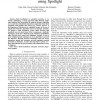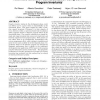ICSE
2012
IEEE-ACM
12 years 8 months ago
2012
IEEE-ACM
—This paper describes a new technique, which automatically selects the most appropriate developers for fixing the fault represented by a failing test case, and provides a diagno...
ECSA
2011
Springer
13 years 5 months ago
2011
Springer
Abstract. An important step in achieving robustness to run-time faults is the ability to detect and repair problems when they arise in a running system. Effective fault detection a...
COMPSAC
2011
IEEE
13 years 5 months ago
2011
IEEE
Abstract—Statistical fault localization techniques find suspicious faulty program entities in programs by comparing passed and failed executions. Existing studies show that such ...
CASES
2011
ACM
13 years 6 months ago
2011
ACM
Cost pressure is driving vendors of safety-critical systems to integrate previously distributed systems. One natural approach we have previous introduced is On-Demand Redundancy (...
ICSM
2009
IEEE
14 years 3 months ago
2009
IEEE
We previously presented a fault localization technique called Value Replacement that repeatedly alters the state of an executing program to locate a faulty statement [9]. The tech...
SRDS
2010
IEEE
14 years 4 months ago
2010
IEEE
Abstract--Fault localization in enterprise networks is extremely challenging. A recent approach called Sherlock makes some headway into this problem by using an inference algorithm...
STVR
2010
14 years 4 months ago
2010
Failures triggered by hard to debug defects usually involve complex interactions between many program elements. We hypothesize that information flows present a good model for such ...
SAC
2008
ACM
14 years 5 months ago
2008
ACM
Despite extensive testing in the development phase, residual defects can be a great threat to dependability in the operational phase. This paper studies the utility of lowcost, ge...
TELSYS
2008
14 years 6 months ago
2008
Increase in the network usage for more and more performance critical applications has caused a demand for tools that can monitor network health with minimum management traffic. Ada...
ISSTA
2010
ACM
14 years 8 months ago
2010
ACM
This paper investigates the application of causal inference methodology for observational studies to software fault localization based on test outcomes and profiles. This methodo...


